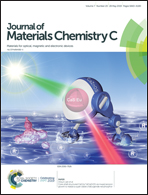Core–shell structured CaS:Eu2+@CaZnOS via inward erosion growth to realize a super stable chalcogenide red phosphor†
Abstract
With outstanding green-to-red spectral conversion ability, CaS:Eu2+ is notorious for its poor chemical and thermal stabilities, which seriously limit its practical applications. Herein, we structure core–shell CaS:Eu2+@CaZnOS phosphors by a convenient solid-state method. The oxysulfide protection layer was formed due to inward incorporation of ZnO into the surface lattice of the CaS substrate. As a result, the surface modified chalcogenide red phosphor shows super stability toward acidic/basic solutions and retains its brightly emissive activity in aqueous solutions with pH = 1–14. Moreover, it exhibits the best thermal resistance behavior for alkaline earth sulfide-based phosphors up to now, maintaining over 95% of the emission intensity till 150 °C. In addition, the QE of the optimal core–shell phosphor in the green region reached 68.78%, which is elevated by ∼23% compared to that of the starting CaS:Eu2+. This is the first time to simultaneously realize a chemically and thermally stable sulfide phosphor, along with high QE, which exhibits good suitability for solar spectral conversion films and light-emitting diodes for facilitating plant growth.



 Please wait while we load your content...
Please wait while we load your content...